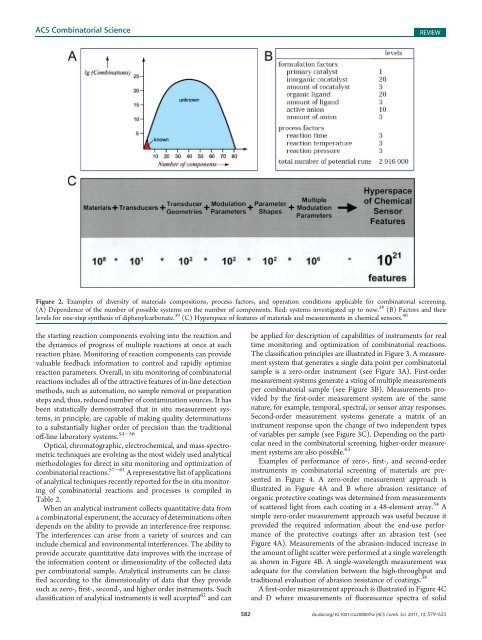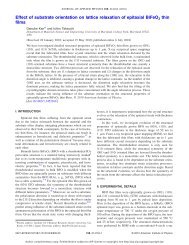Combinatorial and High-Throughput Screening of Materials ...
Combinatorial and High-Throughput Screening of Materials ...
Combinatorial and High-Throughput Screening of Materials ...
You also want an ePaper? Increase the reach of your titles
YUMPU automatically turns print PDFs into web optimized ePapers that Google loves.
ACS <strong>Combinatorial</strong> Science<br />
REVIEW<br />
Figure 2. Examples <strong>of</strong> diversity <strong>of</strong> materials compositions, process factors, <strong>and</strong> operation conditions applicable for combinatorial screening.<br />
(A) Dependence <strong>of</strong> the number <strong>of</strong> possible systems on the number <strong>of</strong> components. Red: systems investigated up to now. 38 (B) Factors <strong>and</strong> their<br />
levels for one-step synthesis <strong>of</strong> diphenylcarbonate. 39 (C) Hyperspace <strong>of</strong> features <strong>of</strong> materials <strong>and</strong> measurements in chemical sensors. 40<br />
the starting reaction components evolving into the reaction <strong>and</strong><br />
the dynamics <strong>of</strong> progress <strong>of</strong> multiple reactions at once at each<br />
reaction phase. Monitoring <strong>of</strong> reaction components can provide<br />
valuable feedback information to control <strong>and</strong> rapidly optimize<br />
reaction parameters. Overall, in situ monitoring <strong>of</strong> combinatorial<br />
reactions includes all <strong>of</strong> the attractive features <strong>of</strong> in-line detection<br />
methods, such as automation, no sample removal or preparation<br />
steps <strong>and</strong>, thus, reduced number <strong>of</strong> contamination sources. It has<br />
been statistically demonstrated that in situ measurement systems,<br />
in principle, are capable <strong>of</strong> making quality determinations<br />
to a substantially higher order <strong>of</strong> precision than the traditional<br />
54 56<br />
<strong>of</strong>f-line laboratory systems.<br />
Optical, chromatographic, electrochemical, <strong>and</strong> mass-spectrometric<br />
techniques are evolving as the most widely used analytical<br />
methodologies for direct in situ monitoring <strong>and</strong> optimization <strong>of</strong><br />
combinatorial reactions. 57 61 A representative list <strong>of</strong> applications<br />
<strong>of</strong> analytical techniques recently reported for the in situ monitoring<br />
<strong>of</strong> combinatorial reactions <strong>and</strong> processes is compiled in<br />
Table 2.<br />
When an analytical instrument collects quantitative data from<br />
a combinatorial experiment, the accuracy <strong>of</strong> determinations <strong>of</strong>ten<br />
depends on the ability to provide an interference-free response.<br />
The interferences can arise from a variety <strong>of</strong> sources <strong>and</strong> can<br />
include chemical <strong>and</strong> environmental interferences. The ability to<br />
provide accurate quantitative data improves with the increase <strong>of</strong><br />
the information content or dimensionality <strong>of</strong> the collected data<br />
per combinatorial sample. Analytical instruments can be classified<br />
according to the dimensionality <strong>of</strong> data that they provide<br />
such as zero-, first-, second-, <strong>and</strong> higher order instruments. Such<br />
classification <strong>of</strong> analytical instruments is well accepted 62 <strong>and</strong> can<br />
be applied for description <strong>of</strong> capabilities <strong>of</strong> instruments for real<br />
time monitoring <strong>and</strong> optimization <strong>of</strong> combinatorial reactions.<br />
The classification principles are illustrated in Figure 3. A measurement<br />
system that generates a single data point per combinatorial<br />
sample is a zero-order instrument (see Figure 3A). First-order<br />
measurement systems generate a string <strong>of</strong> multiple measurements<br />
per combinatorial sample (see Figure 3B). Measurements provided<br />
by the first-order measurement system are <strong>of</strong> the same<br />
nature, for example, temporal, spectral, or sensor array responses.<br />
Second-order measurement systems generate a matrix <strong>of</strong> an<br />
instrument response upon the change <strong>of</strong> two independent types<br />
<strong>of</strong> variables per sample (see Figure 3C). Depending on the particular<br />
need in the combinatorial screening, higher-order measurement<br />
systems are also possible. 63<br />
Examples <strong>of</strong> performance <strong>of</strong> zero-, first-, <strong>and</strong> second-order<br />
instruments in combinatorial screening <strong>of</strong> materials are presented<br />
in Figure 4. A zero-order measurement approach is<br />
illustrated in Figure 4A <strong>and</strong> B where abrasion resistance <strong>of</strong><br />
organic protective coatings was determined from measurements<br />
<strong>of</strong> scattered light from each coating in a 48-element array. 34 A<br />
simple zero-order measurement approach was useful because it<br />
provided the required information about the end-use performance<br />
<strong>of</strong> the protective coatings after an abrasion test (see<br />
Figure 4A). Measurements <strong>of</strong> the abrasion-induced increase in<br />
the amount <strong>of</strong> light scatter were performed at a single wavelength<br />
as shown in Figure 4B. A single-wavelength measurement was<br />
adequate for the correlation between the high-throughput <strong>and</strong><br />
traditional evaluation <strong>of</strong> abrasion resistance <strong>of</strong> coatings. 34<br />
A first-order measurement approach is illustrated in Figure 4C<br />
<strong>and</strong> D where measurements <strong>of</strong> fluorescence spectra <strong>of</strong> solid<br />
582 dx.doi.org/10.1021/co200007w |ACS Comb. Sci. 2011, 13, 579–633












